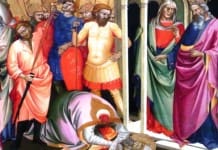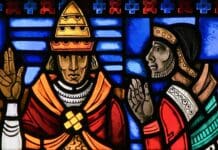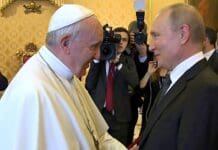Throughout the entirety of World War II, the Holy See and the Vatican maintained a firm stance of neutrality under the terms of the Lateran Treaty of 1929. Despite both Allied and Axis aircraft crews being generally commanded to respect that neutrality throughout the war, twice did the Vatican see bombs dropped within its walls – a story seldom told.
On November 5th, 1943 at 8:10 p.m., the Vatican was bombed for the first time during World War II. A single plane dropped four bombs, completely destroying a mosaic studio near the Vatican railway station, breaking the windows on the high cupola of Saint Peter’s Basilica, and nearly taking out the Vatican Radio building. The famous The Last Supper by Leonardo da Vinci was a near casualty, only protected from shrapnel by sandbags set around it.
Miraculously there were no causalities despite the severe damage, some of which is still visible to this day.
The identity of the lone plane involved in the first bombing of the Vatican is a topic of hot debate, with different eye witness accounts and testimonies involved providing for different perpetrators. Today, historians generally agree the attack was orchestrated by the Italian Fascist politician and anti-clericalist Roberto Farinacci. The aim was to knock out Vatican Radio, as they suspected it was delivering coded messages to Allied forces.
The second bombing of the Vatican during World War II came just three months later on March 1st, 1944, of which the identity of the bomber is of no dispute. An Italian plane dropped six low caliber bombs near the Vatican wall. One workman in the open was casualty to the attack, which also injured a Dutch Augustinian. The Palace of the Holy Office, the Oratory of Saint Peter, and the Pontifical Urban University were damaged in the attack.
“Suddenly two or three very loud explosions made us jump off the table, and it seemed to us that a bomb had broken out in the courtyard. After the first moment of fear, we went downstairs: darkness and silence. We heard a certain buzz, and we opened the door, and we spotted a poor wanderer, struck to death by shrapnel from the bomb, and hurried to give him absolution and ran to get oil.”
Monsignor Giulio Barbetta recounts that in this bombing, despite all the windows of the Holy Office shattering, the glass covering an image of the Virgin Mary between it and the entrance to the Oratory of Saint Peter remained intact, and the oratory suffered little damage. The miraculous protection was attributed to Our Lady, and a sculpture of shield bearing angels was erected with an inscription that reads to this day: AB ANGELIS DEFENSA KAL. MART. A.D. MCMXLIV, “Protected by angels, March 1st, 1944.”
Photo credit: Public Domain via Wikimedia Commons

















